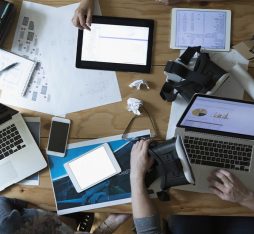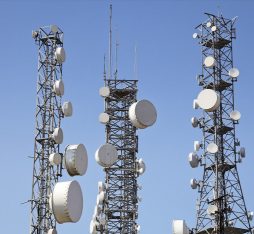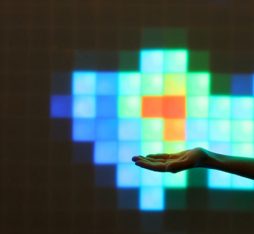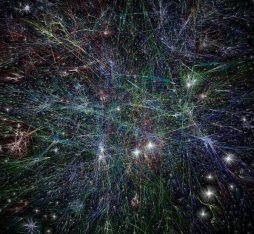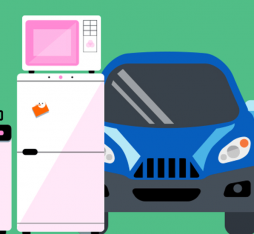“Everyone has a phone these days and it’s really quite easy to consider them as potential relays for connected object data!”
It’s 6 pm and I’m leaving work on my bike. Using GPS coordinates, my connected watch lets my household know I’m on my way. Hang on, I’ve got a message from my fridge: “We need more butter and eggs”. Quick detour to the supermarket and I’m back home. Red alert from my son’s schoolbag: Oscar still isn’t back after rugby training. I check where he is in real time thanks to his connected bike: He’s on his way, just a little bit late! That just about sums up my day, thanks to all these connected objects embedded everywhere! What would I do without them, and without their ultra-optimised, minimal energy-consuming operation? Because, recharging a battery set into a bike… And talking of batteries, there’s one that I can easily charge, in my mobile phone. Everyone has a phone these days and it’s really quite easy to consider them as potential relays for connected object data.
How? Using Device-to-Device (D2D) technology that allows two devices to intercommunicate without the need for a relay antenna (or base station, as it’s also known). 4G already uses this technology, which was initially developed for the public safety authorities (police, fire service, ambulance) to replace their old TETRA (Terrestrial Trunked Radio) communication system, which worked like a walkie-talkie set-up. However, the specific technical features of 4G D2D technology do not allow it to be used as is for a network of connected objects restricted by cost and energy consumption: The protocols employed are too complex and energy-intensive to be used for IoT devices. Hence, Orange Research has put its efforts into developing a D2D mechanism dedicated to cellular networks of connected objects and taking advantage of the considerable number of mobile phones out there. The aim of the system is to use the communication made possible between a connected object and a mobile phone. The latter can therefore serve as a relay to transfer messages from the connected object to the base station. We are talking about a D2D relay system.
Two potential scenarios for D2D relaying

Figure 1: Two D2D relay scenarios
Two relay scenarios can be envisaged, the first relaying data from a connected object (called a Machine Type Device (MTD) in Figure 1) located in an area of poor coverage (Scenario 1), and the second simply transmitting this data as the object is not connected to the base station (Scenario 2). In the first scenario, the main benefit of the D2D relay system is to reduce energy consumption and allow the device to run for longer on its battery. The further a device is from the base station, the louder and longer it has to talk to be heard, thereby consuming energy. Relaying is like getting closer to the base station, which reduces the energy consumed during data transmission. In the second scenario, an object can be connected where it wasn’t before!
That may seem simple but there’s more to it than that, especially when the “low-cost, non-complex” restriction comes into the equation.
There are two phases in a D2D relay system: one of seeking out nearby devices as potential relays, and a communication phase. The aim, of course, is to reduce energy consumption in both phases. The protocol for discovering potential relays needs to be as simple and energy efficient as possible.
A protocol for discovering potential relays that’s simple to deploy and ensures low energy usage for the communicating device
To meet this challenge, we took an existing protocol called RTS/CTS (Ready-To-Send/Clear-To-Send) and adapted it to suit our needs. Our adapted RTS/CTS protocol is illustrated in Figure 2. The connected object delimits a search area. This area has to be a compromise between a wide search area, where there are too many potential relays leading to excess time and battery power spent searching for the right one, and a small area, where the chances of finding a relay will be very slim. In our example in Figure 2, five phones can act as relays in the search area for the connected object.
The phase of discovering nearby devices and selecting a relay works as follows:
The MTD sends an RR (Request-for-Relay) message which is an announcement to all phones in the search area (broadcast message). Then, it waits for a response from potential relayers. The phones (called UEs) that receive the message respond by sending an RC (Relay-Candidate) message in a time window chosen at random from W windows available. The closer you are to an MTD, the greater the chance of a response in the first time windows, so choose a relay that’s not too far away! If two UEs choose the same time window, there will be a collision and the RC messages will not be received by the MTD (as per our example for UEs 2 and 4). The only one to be received, in our example, is UE 5 in time window 3. The MTD then sends all the other UEs a “feedback” message in “broadcast” mode to inform UE 5 that it has been selected and to notify the other UEs that a relay has been found and the discovery phase can stop. The MTD sends the data, in D2D mode, to the selected UE, which relays said data to the base station using its 4G connection.

Figure 2: Protocol for discovering potential relays
The key parameters to set for optimum energy consumption are the radius of the relay search area, the number of time windows W available and, finally, where the cursor is positioned to decide the chance percentages of the different UEs sending their RC message in the first time windows.
Proven efficiency for connected objects with poor network coverage
An initial result obtained implying that all UEs have the same chance of sending the message in all the time windows, irrespective of distance, is illustrated in Figure 3. We can see that it becomes of interest to use D2D mode in terms of energy consumption when the data for transmission is of a significant size and the MTD is remote from the base station and therefore in less-than-ideal connection conditions. This is the area in Figure 3 where the red curve goes above the green one.
The next step will be to make the energy consumption comparison by actually favouring the UEs closest to the connected object.

Figure 3: Comparison of energy consumption (in mJ) in D2D mode and direct transmission mode for different distances (in m) between the connected object and the base station and different sizes of messages to be sent (in bytes).
This relaying obviously has an energy cost for the mobiles that serve as relays. We were able to quantitatively assess this cost in the discovery phase, where it is around 0.5 mJ. Add to this the energy cost for sending a small message of a few hundred bytes maximum and the total cost of relaying—a few mJ—is negligible compared to the conventional use of a smartphone, which is several hundred Joules for video streaming, for example.
Finally, some important questions may be raised, not necessarily answered in this article but under consideration by a number of researchers. There is of course the issue of the safety of such a system, and how to guarantee a level of security for messages circulating from one device to another that is equivalent to that of the cellular networks. Another important question concerns incentive, or how to encourage mobile users to participate in this relay system.
Taking it further, a considerable amount of work is ongoing with 3GPP, the standardisation organisation responsible for developing technical protocols for the different generations of cellular networks. The main aim is to be able to benefit from this device-to-device communication technology in the upcoming 5G network for a whole raft of uses from communication between two vehicles to applications for the industry of the future. The challenges are real, since 5G Sidelink (the other name for D2D technology) should be at once low energy consuming, highly responsive and reliable, and it should also make possible this very broad range of applications, including D2D relaying.
So let’s finish by imagining a communicating device embedded in a schoolbag, a bike or a case and not just slipped into a pocket or slung under a saddle: With D2D relaying, we can have situations where it is no longer necessary to recharge the battery for the entire lifecycle of the object.
Learn more
Orange has participated in the ONE5G collaborative project through work carried out on D2D relaying for the Internet of Things 5G network: https://one5g.eu/
The results of the work discussed in this article have also been presented at a conference: C. Vargas Anamuro, N. Varsier, J. Schwoerer and X. Lagrange, “Energy-efficient discovery process for mMTC applications”, WMNC, September 2019, Paris
All the work carried out by Cesar as part of his thesis is detailed in his manuscript available at http://www.theses.fr/s201699




